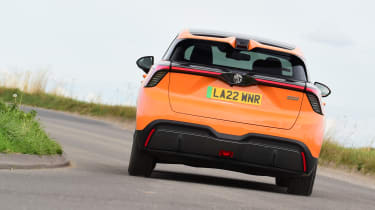MG4 Trophy 2023 review
MG’s all-electric warm hatch has an affordable price on its side to take on the established EV hatch sector
You remember MG, the maker of Midgets and Bs that introduced the world to affordable sports cars. Later on it became a trim level for everything from Metros to Montegos before returning to its sports car routes with the MGF and a series of rebadged hatches and saloons, before disappearing altogether when the Phoenix Four did a bunk with the corporate credit card, leaving the remaining assets to be sold to China’s Nanjing Automobile in 2005. Rights to the MG 25 and 75 were sold to another Chinese conglomerate, SAIC, the previous year.
Today MG is owned and sold by SAIC following a merger with Nanjing in 2007, and the brand returned to the UK in 2011 with the MG6. Since then, a steady flow of anonymous hatches, saloons, estates and crossovers have appeared with both petrol and battery power, including the 4; an all-electric hatch that’s considered mildly warm in the context of other hatchbacks.
The MG4 EV is neither a two-seater sports car nor a hot hatch with some red stickers and bold claims of out-accelerating a Ferrari Testarossa, but it is quite possibly the best electric-powered hatchback on sale today, although admittedly that’s a pretty shallow pool of excellence to go fishing in.
More reviews
Group tests
- Alpine A290 v Alpine A110 – how much DNA do they really share?
- Ariel Atom 4R v Caterham Seven ‘evo25’: power-to-weight heroes go head-to-head
- Aston Martin Vantage vs Audi R8 V10 RWD – back to basics
- Caterham Super Seven 600 v Super Seven 2000
- Levante v T1
- Corvette Stingray v Porsche Cayman GTS v Audi R8 RWD
- Great Ferrari hypercars driven: 288 GTO, F40, F50 and Enzo head-to-head
- Lamborghini Aventador Ultimae v Lamborghini Countach
- Lotus Emira v Morgan Plus Four – four-cylinder Brits go head-to-head
- Toyota GR86 v BBR Mazda MX-5: supercharged drop-top battles sports coupe
In-depth reviews
- Abarth 600e 2025 review – Italy gives the Alpine A290 something to worry about
- Alpine A110 review – distinctive, lightweight and unforgettable to drive
- Audi RS7 Sportback Performance review
- Bentley Continental R Mulliner: review, history and specs
- BMW 5-series review – is this still Munich’s anchor model?
- BMW 1-series review – Munich’s Audi A3 rival gains focus
Long term tests
- Abarth 695C Turismo Fast Fleet test – 10,000 miles in the Italian hot hatch
- Alfa Romeo Giulia Veloce Fast Fleet test – 7000 miles in the sharp Italian saloon
- Alpina B10: end of term report
- Alpina B10
- Ford Mustang GT
- Ford Mustang GT
- Ford Mustang GT
- Land Rover Defender 110 Fast Fleet test – 9000 miles in the go-anywhere SUV
- Maserati Ghibli Trofeo Fast Fleet test – 4000 miles in the Ferrari-powered saloon
- Mitsubishi Evo MR 340
Review
- New Aston Martin DBS 770 Ultimate review – 759bhp super-GT driven
- New Bentley Batur 2023 review – can it possibly be worth £1.65m?
- 2023 Chevrolet Corvette C8 Z06 review – the American 911 GT3?
- Kia EV6 GT-Line S prototype review – the EV that shows how it’s done
- BBR Supercharged Mazda MX-5 (ND) 2023 review – tuned 250bhp roadster driven
Reviews
- Abarth 695 75 Anniversario edition 2024 review – a fitting send-off for Abarth’s hot supermini?
- Abarth 500e 2023 review
- AC Cobra 378 Superblower MkIV 2021 review – another V8 Cobra, but with a GM heart this time
- Acura Integra Type S 2024 review – a Honda Civic Type R with added restraint
- Alfa Romeo Giulia 2025 review – get one while you still can
- Alfa Romeo SZ: history, review and specs of an icon
- Alfa Romeo 1750 TBi
- Alpina B3 GT Touring 2025 review – a 190mph alternative to the BMW M3 Touring
Obvious and natural rivals come from the usual suspects within the VW Group (VW’s ID.3 and Cupra’s Born), Renault’s Mégane E-Tech and electric variants of other ‘traditional’ size hatchbacks. The MG’s trick, however, is that despite its similar footprint it doesn’t take on the look and presence of a crossover/SUV, and it’s all the better for it. Its wedge design isn’t to all tastes and it suits more sober exterior colours than the Volcano Orange pictured here, but while it could never be described as a clean, flowing design, neither is it a high-riding anonymous blob.
Built on MG’s Modular Scalable Platform (MSP), the 64kWh battery fitted to this Trophy Long Range model is central to the ‘skateboard’ structure on which the car is built. There are MacPherson struts at the front and a simple independent spring and damper setup at the rear, with a set of modest 17-inch wheels the only choice. This all makes for a 50:50 weight distribution, and with the 200bhp, 184lb ft motor positioned where a fuel tank would usually be, the MG4 is, like many EVs, rear‑wheel drive. The recently announced XPower version gains a front motor for 429bhp.
Weighing 1685kg it’s not a flyer of a hot hatch, with a 7.7sec 0-62mph time and 121bhp/ton power-to-weight ratio putting it on a par with Peugeot’s S2 106 Rallye. Some might compare the MG4’s interior with that of the mid-’90s French hottie, too, the finishing to some of the plastic surfaces closer to the scratchy end of the scale than you’ll find in the majority of ICE cars on sale today.
However, the overall look and feel inside, despite being rather uninspiring as per many of its rivals, doesn’t jar. The controls are intuitively positioned, the HMI system works with clarity, and moving through its menus isn’t an exercise that leaves you wanting to rip it from the interior with a crowbar and send it back piece by piece to its creator. Although like many smaller EVs, the instrument cluster is far too small for the irrelevant data that’s been squeezed onto the screen, the ‘speedometer’ seemingly an afterthought. And the driver’s seat offers little support: its base is too short, so it doesn’t provide enough under-thigh support, and there isn’t a tilt adjustment to avoid that feeling of being tipped out into the footwell.
It drives well, though. Its performance is more enthusiastic sparkler than EV rocket: the pick up from stationary or on the move is as you should expect given the quoted outputs, but those who believe EVs are faster than light itself will be left confused as to why a Skoda Yeti has dropped them on the exit of a roundabout. But it rides well, suspension noise is nicely isolated, and while there’s some old-school pitch and roll it controls and reacts with a neutrality, allowing you to position the car neatly on the road and pour it cleanly into a corner.
There’s nothing to feel through the steering, rather you need to sense when the tyres are beginning to make a break for freedom and modulate accordingly. But turn-in is impressive, with drive through and out of a corner strong enough for you to feel the rear settling and pushing you along, that 50:50 weight distribution paying dividends.
There is not, however, enough on offer to make you want to take the 4 for a drive for the sake of it. Like its rivals, its one-dimensional set-up fails to deliver anything approaching character or personality. Or thrills.
However, the MG4 does appeal if you require a device for simply getting from point A to any other point within the Trophy’s claimed 270-mile range. As a car for weekly driving chores where efficiency trumps engagement, it makes a compelling case for itself. More so when you factor in the price, which starts at £26,995 for the 125kW/168bhp SE with a 218-mile range, and climbs to £32,495 for the range-topping Trophy, the latter being a sizable four- and five-thousand pounds less respectively than the inferior Cupra Born and VW ID.3 equivalents.
Price and rivals
That £32,495 starting price for the MG4 Trophy makes it £3980 cheaper than the entry-level 58kWh Cupra Born V1, and you’ll need to spend £41,975 for a Born V2 with a larger 77kWh battery. VW’s ID3 Pro with a 58kWh battery starts at £37,115 and climbs to £42,870 for a rear-drive model powered by the 77kWh unit.
Renault’s Megane E-Tech starts from £36,995 and is only available with a 60kWh battery regardless of the trim level selected. If you are after a more conventional looking car from the sector, Vauxhall will sell you an electric Astra with a 54kWh battery for £39,995.







